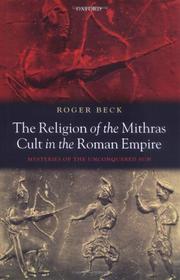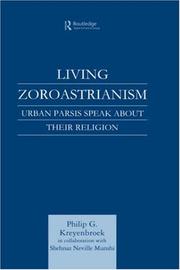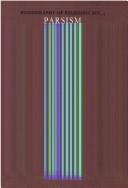| Listing 1 - 10 of 32 | << page >> |
Sort by
|
Book
ISBN: 9004357734 Year: 2018 Publisher: Leiden, The Netherlands ; Boston, [Massachusetts] : Brill,
Abstract | Keywords | Export | Availability | Bookmark
 Loading...
Loading...Choose an application
- Reference Manager
- EndNote
- RefWorks (Direct export to RefWorks)
The manuscript S1 is one of the chief witnesses to the Sanskrit Yasna, containing the Avestan text of the Zoroastrian Yasna liturgy to chapter 46.19, together with a Sanskrit translation and commentary. This book contains the complete, full-colour set of facsimile images of S1. An introduction by Leon Goldman provides an overview of the Zoroastrian Sanskrit tradition together with a discussion of the S1 manuscript covering its physical appearance, its age and history, and for the first time, a detailed palaeographic analysis of the Avestan and Sanskrit text.
Book
ISBN: 1136836012 1280684585 9786613661524 1136836020 0203832396 9780203832394 9780415609746 0415609747 Year: 2011 Publisher: London New York Routledge
Abstract | Keywords | Export | Availability | Bookmark
 Loading...
Loading...Choose an application
- Reference Manager
- EndNote
- RefWorks (Direct export to RefWorks)
Throughout his life the Shams-ul-Ullema devoted himself to advancing the Zoroastrian Faith, not only as a priest and teacher, but also as a writer. This volume of papers is authored by an international group of scholars and covers the history, philosophy, literature and language of Persia and the Indo-Iranians.
Book
ISBN: 9004433953 Year: 2021 Publisher: Leiden, The Netherlands ; Boston : Brill,
Abstract | Keywords | Export | Availability | Bookmark
 Loading...
Loading...Choose an application
- Reference Manager
- EndNote
- RefWorks (Direct export to RefWorks)
"Laws of Ritual Purity: Zand īFragard īJud-Dēw-Dād (A Commentary on the Chapters of the Widēwdād) describes the various ways in which Zoroastrian authorities in the fifth-sixth centuries CE reinterpreted the purity laws of their community. Its redactor(s), conversant with the notions and practices of purity and impurity as developed by their predecessors, attempt(s) to determine the parameters of the various categories of pollution, the minimum measures of polluted substances, and the effect of the interaction of pollution with other substances that are important to humans. It is therefore in essence a technical legal corpus designed to provide a comprehensive picture of a central aspect of Zoroastrian ritual life: the extent of one's liability contracting pollution and how atonement/purification can be achieved"--
Purity, Ritual --- Zoroastrianism. --- Avesta.
Book
ISBN: 1474442900 1474442919 1474442889 9781474442916 9781474442886 Year: 2020 Publisher: Edinburgh
Abstract | Keywords | Export | Availability | Bookmark
 Loading...
Loading...Choose an application
- Reference Manager
- EndNote
- RefWorks (Direct export to RefWorks)
Zeini challenges the view that considers the Zand's study an auxiliary science to Avestan studies, framing the text instead within the exegetical context from which it emerged.
Zoroastrianism --- Mazdaism --- Mazdeism --- Religions --- Mithraism --- Avesta. --- E-books --- Zoroastrianism.
Book
ISBN: 1463215150 4064066160609 9700000029109 Year: 2009 Publisher: Piscataway, NJ : Gorgias Press,
Abstract | Keywords | Export | Availability | Bookmark
 Loading...
Loading...Choose an application
- Reference Manager
- EndNote
- RefWorks (Direct export to RefWorks)
The Parsis, descendants of the ancient Persians, are a Zoroastrian people that have survived into modern times. Dauphine Menant’s classic study on the history of the Parsis in India is made available in its first French edition. In the style of the travelogue, the study contains illustrations of parts of the Parsis life in the late nineteenth century. Twenty-one plates as well as illustrations within the text serve the valuable function of enabling the reader to visualize this swiftly disappearing culture. This basic introduction to the history and life of the Parsis will appeal to those interested in the state of religious minorities in Asia, as well as those who are researching the living traditions of Zoroastrianism
Zoroastrianism. --- Mazdaism --- Mazdeism --- Religions --- Mithraism
Book
ISBN: 1350989436 0857728156 0857728865 9780857728159 9780857728869 9781784536336 1784536334 Year: 2016 Publisher: London, England : London, England : I.B. Tauris & Co. Ltd, Bloomsbury Publishing,
Abstract | Keywords | Export | Availability | Bookmark
 Loading...
Loading...Choose an application
- Reference Manager
- EndNote
- RefWorks (Direct export to RefWorks)
"Zoroastrianism has always commanded interest way beyond the circles of its actual adherents. Its unbroken history and distinctive beliefs span three millennia, making it one of the world's most venerable faiths - and also a tradition whose ideas have found favour elsewhere. The Three Magi of the New Testament most probably were Zoroastrian priests from the Iranian world; while the enigmatic figure of Zarathushtra (or Zoroaster) himself has exerted continual fascination in the West, influencing the thought of creative artists as diverse as Voltaire, Nietzsche, Yeats and Mozart (whose opera The Magic Flute re-imagines Zoroaster as Sarastro). For many centuries, from the birth of the religion late in the second millennium BC to its later adoption in the third century AD as the state religion of the Sasanian empire, Zoroastrianism - enjoying imperial patronage - profoundly shaped the culture not just of Persia but the whole antique world. For much of its history since the Islamic conquest it has endured as a minority religion, representing a direct link back to the powerful Achaemenids and the ruling Persian dynasties that followed them. The remarkable Zoroastrian story began another chapter in India when, after partial exodus from Iran, the émigré community since the early ninth century has enjoyed religious freedom and in the modern period great economic success. Like many religious communities, Zoroastrians now have a diaspora spread all over the globe."--Front jacket flap.
Zoroastrianism. --- Mazdaism --- Mazdeism --- Religions --- Mithraism

ISBN: 1280753307 0191518239 1429421193 9780191518232 0198140894 9780198140894 9781280753305 9780191712128 0191712124 9780199216130 0199216134 9781429421195 661075330X 9786610753307 Year: 2007 Publisher: Oxford New York
Abstract | Keywords | Export | Availability | Bookmark
 Loading...
Loading...Choose an application
- Reference Manager
- EndNote
- RefWorks (Direct export to RefWorks)
A study of the religious system of Mithraism, one of the 'mystery cults' popular in the Roman Empire contemporary with early Christianity. Mithraism is described from the point of view of the initiate engaging with its rich repertoire of symbols and practices. - ;A study of the religious system of Mithraism, one of the 'mystery cults' popular in the Roman Empire contemporary with early Christianity. Roger Beck describes Mithraism from the point of view of the initiate engaging with the religion and its rich symbolic system in thought, word, ritual action, and cult life. He employs the methods
Mithraism. --- Mithras (Zoroastrian deity) --- Zoroastrianism --- Rome --- Religion.

ISBN: 9781136119620 1136119620 070071328X 9780700713288 1283963981 0203037138 9780203037133 9781136119705 9781136119781 9781138862456 1136119701 Year: 2001 Publisher: Richmond Curzon
Abstract | Keywords | Export | Availability | Bookmark
 Loading...
Loading...Choose an application
- Reference Manager
- EndNote
- RefWorks (Direct export to RefWorks)
This text describes the realities of modern Parsi religion through 30 interviews in which urban Parsis belonging to different social milieus and religious schools of thought discuss various aspects of their religious lives.Zoroastrianism, the faith founded by the Iranian prophet Zarathustra, originated around 1000BCE and is widely regarded as the world's first revealed religion. Although the number of its followers declined dramatically in the centuries after the 7th century Islamic conquest of Iran, Zoroastrians survive in Iran to the present day. The other major Zoroastrian communi
Zoroastrianism --- Mazdaism --- Mazdeism --- Religions --- Mithraism --- Influence.
Book
ISBN: 1474489540 1474489559 1474489524 Year: 2023 Publisher: Edinburgh : Edinburgh University Press,
Abstract | Keywords | Export | Availability | Bookmark
 Loading...
Loading...Choose an application
- Reference Manager
- EndNote
- RefWorks (Direct export to RefWorks)
The second Muslim caliph, Umar ibn al-Khattab, once reportedly exclaimed, 'I do not know how to treat Zoroastrians!' He and other Muslims encountered Zoroastrians during the conquest of Arabia but struggled to formulate a consistent policy toward the adherents of a religion that was neither biblical nor polytheistic. Some Muslims saw Zoroastrians as pagans and sought to limit interaction with them. Others found ways to incorporate them within the empire of Islamic law. Andrew D. Magnusson describes the struggle between advocates of inclusion and exclusion, the ultimate accommodation of Zoroastrians, and the reasons that Muslim historians have subsequently buried the memory of this relationship.
Islam --- Zoroastrianism --- Zoroastrians --- HISTORY / Middle East / Iran. --- Relations --- Zoroastrianism. --- History. --- Islam. --- Parsees --- Religious adherents

ISBN: 0585245207 9780585245201 9004062084 9789004062085 900466677X Year: 1980 Publisher: Leiden Brill
Abstract | Keywords | Export | Availability | Bookmark
 Loading...
Loading...Choose an application
- Reference Manager
- EndNote
- RefWorks (Direct export to RefWorks)
Zoroastrianism. --- Parsee art. --- Art, Parsic --- Art --- Mazdaism --- Mazdeism --- Religions --- Mithraism
| Listing 1 - 10 of 32 | << page >> |
Sort by
|

 Search
Search Feedback
Feedback About UniCat
About UniCat  Help
Help News
News